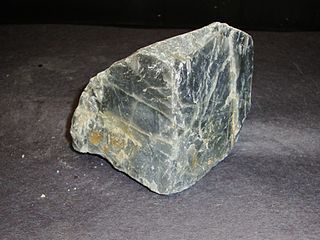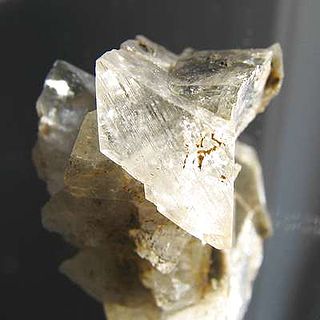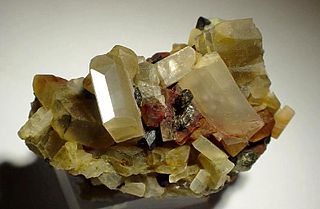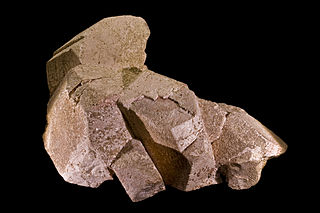 W
WAlbite is a plagioclase feldspar mineral. It is the sodium endmember of the plagioclase solid solution series. It represents a plagioclase with less than 10% anorthite content. The pure albite endmember has the formula NaAlSi3O8. It is a tectosilicate. Its color is usually pure white, hence its name from Latin albus. It is a common constituent in felsic rocks.
 W
WAndesine is a silicate mineral, a member of the plagioclase feldspar solid solution series. Its chemical formula is (Ca, Na)(Al, Si)4O8, where Ca/(Ca + Na) (% anorthite) is between 30–50%. The formula may be written as Na0.7-0.5Ca0.3-0.5Al1.3-1.5Si2.7-2.5O8.
 W
WAnorthite is the calcium endmember of the plagioclase feldspar mineral series. The chemical formula of pure anorthite is CaAl2Si2O8. Anorthite is found in mafic igneous rocks. Anorthite is rare on the Earth but abundant on the Moon.
 W
WBarrerite is a tectosilicate mineral and a member of the zeolite family. It is one of the rarer zeolites. It was named for Richard Barrer, a New Zealand-born chemist.
 W
WBicchulite has an ideal chemical formula of 2CaO •Al2O3 •SiO2 •H2O, which was formularized from the hydrothermal synthesis of synthetic gehlenite (2CaO •Al2O3 •SiO2). Also, bicchulite was sighted in the mines of Japan with related minerals. This sodalite-type structured bicchulite has an uncommon ratio of aluminium to silicon, causing difficulties deciphering the structure. Because of bicchulite's structure it has a powdery texture, which leads to complications in obtaining information on the mineral's physical properties. Despite this problem, the color, specific gravity, and crystal size of bicchulite are known. Although bicchulite was only discovered about 40 years ago, technology has been rapidly advancing, allowing more accurate results to be made from experiments done today.
 W
WBrewsterite is the name of a series of tectosilicate minerals of the zeolite group. Prior to 1997, brewsterite was recognized as a mineral species, but a reclassification in 1997 by the International Mineralogical Association changed it to a series name, with the mineral species being named brewsterite-Sr and brewsterite-Ba. Brewsterite-Sr, the more common of these, is a hydrous strontium and aluminium silicate, (Sr,Ba)2Al4Si12O32·10H2O. Small amounts of barium is usually present replacing part of the strontium. The appropriate species name depends on the dominant element. The species are visually indistinguishable, and the series name brewsterite is still used whenever testing has not been performed.
 W
WBytownite is a calcium rich member of the plagioclase solid solution series of feldspar minerals with composition between anorthite and labradorite. It is usually defined as having between 70 and 90%An (formula: (Ca0.7-0.9,Na0.3-0.1)[Al(Al,Si)Si2O8]). Like others of the series, bytownite forms grey to white triclinic crystals commonly exhibiting the typical plagioclase twinning and associated fine striations.
 W
WChabazite is a tectosilicate mineral of the zeolite group, closely related to gmelinite, with the chemical formula (Ca,K2,Na2,Mg)Al2Si4O12•6H2O. Recognized varieties include Chabazite-Ca, Chabazite-K, Chabazite-Na, and Chabazite-Sr, depending on the prominence of the indicated cation.
 W
WDanburite is a calcium boron silicate mineral with a chemical formula of CaB2(SiO4)2.
 W
WFeldspars (KAlSi3O8 – NaAlSi3O8 – CaAl2Si2O8) are a group of rock-forming tectosilicate minerals that make up about 41% of the Earth's continental crust by weight.
 W
WHeulandite is the name of a series of tecto-silicate minerals of the zeolite group. Prior to 1997, heulandite was recognized as a mineral species, but a reclassification in 1997 by the International Mineralogical Association changed it to a series name, with the mineral species being named:Heulandite-Ca Heulandite-Na Heulandite-K Heulandite-Sr Heulandite-Ba.
 W
WHsianghualite is a tectosilicate of lithium, calcium and beryllium, with fluorine, a member of the zeolite group. It was discovered in 1958 and named for the type locality, Hsiang Hua, 香花, meaning fragrant flower.
 W
WHyalophane or jaloallofane is a crystalline mineral, part of the feldspar group of tectosilicates. It is considered a barium-rich potassium feldspar. Its chemical formula is (K,Ba)[Al(Si,Al)Si2O8], and it has a hardness of 6 to 6 1⁄2. The name hyalophane comes from the Greek hyalos, meaning "glass", and phanos meaning "to appear".
 W
WIranite (Persian: ایرانیت) is a triclinic lead copper chromate silicate mineral with formula Pb10Cu(CrO4)6(SiO4)2(F,OH)2. It was first described from an occurrence in Iran. It is the copper analogue of hemihedrite (Pb10Zn(CrO4)6(SiO4)2(F,OH)2).
 W
WLabradorite ((Ca, Na)(Al, Si)4O8), a feldspar mineral, is an intermediate to calcic member of the plagioclase series. It has an anorthite percentage (%An) of between 50 and 70. The specific gravity ranges from 2.68 to 2.72. The streak is white, like most silicates. The refractive index ranges from 1.559 to 1.573 and twinning is common. As with all plagioclase members, the crystal system is triclinic, and three directions of cleavage are present, two of which are nearly at right angles and are more obvious, being of good to perfect quality. (The third direction is poor.) It occurs as clear, white to gray, blocky to lath shaped grains in common mafic igneous rocks such as basalt and gabbro, as well as in anorthosites.
 W
WMarialite is a silicate mineral with a chemical composition of Na4Al3Si9O24Cl if a pure endmember or Na4(AlSi3O8)3(Cl2,CO3,SO4) with increasing meionite content. Marialite is a member of the scapolite group and a solid solution exists between marialite and meionite, the calcium endmember. It is a rare mineral usually used as a collector's stone. It has a very rare but attractive gemstones and cat's eye.
 W
WMeionite is a tectosilicate belonging to the scapolite group with the formula Ca4Al6Si6O24CO3. Some samples may also contain a sulfate group. It was first discovered in 1801 on Mt Somma, Vesuvius, Italy. It was named by Rene Just Haüy after μειωυ, the Greek word for less, in reference to the less acute pyramidal form as compared to Vesuvianite.
 W
WMicrocline (KAlSi3O8) is an important igneous rock-forming tectosilicate mineral. It is a potassium-rich alkali feldspar. Microcline typically contains minor amounts of sodium. It is common in granite and pegmatites. Microcline forms during slow cooling of orthoclase; it is more stable at lower temperatures than orthoclase. Sanidine is a polymorph of alkali feldspar stable at yet higher temperature. Microcline may be clear, white, pale-yellow, brick-red, or green; it is generally characterized by cross-hatch twinning that forms as a result of the transformation of monoclinic orthoclase into triclinic microcline.
 W
WNatrolite is a tectosilicate mineral species belonging to the zeolite group. It is a hydrated sodium and aluminium silicate with the formula Na2Al2Si3O10 • 2H2O. The type locality is Hohentwiel, Hegau, Germany.
 W
WOligoclase is a rock-forming mineral belonging to the plagioclase feldspars. In chemical composition and in its crystallographic and physical characters it is intermediate between albite (NaAlSi3O8) and anorthite (CaAl2Si2O8). The albite:anorthite molar ratio of oligoclase ranges from 90:10 to 70:30.
 W
WOrthoclase, or orthoclase feldspar (endmember formula KAlSi3O8), is an important tectosilicate mineral which forms igneous rock. The name is from the Ancient Greek for "straight fracture," because its two cleavage planes are at right angles to each other. It is a type of potassium feldspar, also known as K-feldspar. The gem known as moonstone (see below) is largely composed of orthoclase.
 W
WPlagioclase is a series of tectosilicate (framework silicate) minerals within the feldspar group. Rather than referring to a particular mineral with a specific chemical composition, plagioclase is a continuous solid solution series, more properly known as the plagioclase feldspar series. This was first shown by the German mineralogist Johann Friedrich Christian Hessel (1796–1872) in 1826. The series ranges from albite to anorthite endmembers (with respective compositions NaAlSi3O8 to CaAl2Si2O8), where sodium and calcium atoms can substitute for each other in the mineral's crystal lattice structure. Plagioclase in hand samples is often identified by its polysynthetic crystal twinning or 'record-groove' effect.
 W
WThe scapolites (Gr. σκάπος, rod, and λίθος, stone) are a group of rock-forming silicate minerals composed of aluminium, calcium, and sodium silicate with chlorine, carbonate and sulfate. The two endmembers are meionite (Ca4Al6Si6O24CO3) and marialite (Na4Al3Si9O24Cl). Silvialite (Ca,Na)4Al6Si6O24(SO4,CO3) is also a recognized member of the group.
 W
WStellerite is a rare mineral discovered by and named after Georg Wilhelm Steller, a German explorer and zoologist. The mineral has a general formula of Ca[Al2Si7O18]·7H2O. Like most rare minerals, there are few commercial uses for stellerite. Mineral collectors are lucky to find it in good enough crystal form. Zeolites, including stellerite, have been studied using a dehydration process to gauge the potential use of their phases as molecular sieves, sorbents, and catalysts.
 W
WStilbite is the name of a series of tectosilicate minerals of the zeolite group. Prior to 1997, stilbite was recognized as a mineral species, but a reclassification in 1997 by the International Mineralogical Association changed it to a series name, with the mineral species being named:stilbite-Ca stilbite-Na
 W
WThomsonite is the name of a series of tecto-silicate minerals of the zeolite group. Prior to 1997, thomsonite was recognized as a mineral species, but a reclassification in 1997 by the International Mineralogical Association changed it to a series name, with the mineral species being named thomsonite-Ca and thomsonite-Sr. Thomsonite-Ca, by far the more common of the two, is a hydrous sodium, calcium and aluminium silicate, NaCa2Al5Si5O20·6H2O. Strontium can substitute for the calcium and the appropriate species name depends on the dominant element. The species are visually indistinguishable and the series name thomsonite is used whenever testing has not been performed. Globally, thomsonite is one of the rarer zeolites.
 W
WZeolites are microporous, aluminosilicate minerals commonly used as commercial adsorbents and catalysts. The term zeolite was originally coined in 1756 by Swedish mineralogist Axel Fredrik Cronstedt, who observed that rapidly heating the material, believed to have been stilbite, produced large amounts of steam from water that had been adsorbed by the material. Based on this, he called the material zeolite, from the Greek ζέω (zéō), meaning "to boil" and λίθος (líthos), meaning "stone". The classic reference for the field has been Breck's book Zeolite Molecular Sieves: Structure, Chemistry, And Use.